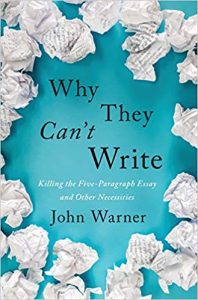by RACHEL GEVLIN


John Warner, Why They Can’t Write: Killing the Five-Paragraph Essay and Other Necessities (Johns Hopkins University Press, November 2018), pp. 288
—, The Writer’s Practice: Building Confidence in Your Nonfiction Writing (Penguin, February 2019), pp. 256
“What you’re reading obscures many realities of the writer’s practice,” writes John Warner in Why They Can’t Write: Killing the Five-Paragraph Essay and Other Necessities. Warner, a professor of creative writing at the College of Charleston who has taught writing at the college level for two decades, pulls from his experiences both as an instructor and a writer, often reflecting on his own challenges in putting together the very book we’re reading. In doing so, he aims to show how disconnected these two things—the pedagogy and the practice of writing—have become in the college classroom. Pointing not only to the ways in which teachers are not letting their students learn to write well, but also to the larger structural problems in America’s education system, Why They Can’t Write is as much about education policy as it is about the day-to-day of what goes on in the classroom. Ultimately, Warner offers a thorough and expansive answer to the question posed by his title.
Before turning to questions of educational structure, Warner engages in a lengthy discussion of writing pedagogy as it is currently conceived of in the American classroom. Arguing that good writing is “revealed by the doing,” Warner shows how the “shortcuts” that students are instructed to take in order to make their writing more efficient prevents them from achieving the very objectives of writing at all. Warner pushes back against the type of assignments that have become standard in the American curriculum, illustrating how students who are taught that writing is a series of concrete tasks become alienated from the very meaning of the practice of writing—the joy of thinking our way through a problem and articulating that thinking to others. The way forward, Warner argues, is to allow students to write in ways that mirror writing in the real world on topics they’re already experts in and for audiences who go beyond their instructor.
The bulk of Warner’s analysis, however, turns towards what he identifies as structural and rhetorical problems in America’s education system writ large. Education, he says, is “an ongoing process, not a product.” Although this may be truer for writing than for anything else, America’s obsession with quantitative assessment is evident across the disciplines. Pointing to the many new fads that investments in instructional technology have brought into the classroom, Warner argues that education policymaker’s focus on real-time data and students’ obsession with getting As risk the same type of shortcomings: by concentrating on the data we can count, we risk obscuring the arguably more important components of learning that are bound up in processes that are less quantifiable. What’s more, Warner points out, America’s increased obsession with quantitative testing does not, as it would purport to, measure student success meritocratically. Rather, this fascination with numerical data reveals already existing structural inequalities based in racial inequity and poverty.
If writing instruction works as the prime example of how American education has it wrong, then where do we go from here? Warner proposes three categories of solutions. The first—very much building from his initial discussion of the ills of writing pedagogy—is to reframe our assignments, treating them more as “writing experiences” than as checkpoints to pass through on a well-marked road to good writing. Emphasizing the importance of failure in this learning process, Warner outlines just a few examples of what these writing experiences might look like, including dissecting the logic behind a standup comedian’s act or asking students to provide argumentative evidence for the ongoing debate of whether or not a hot dog is, indeed, a sandwich. Warner’s second solution involves educators offering more thoughtful and constructive criticisms of students’ work, using qualitative and specific terms to evaluate student writing and reassessing our models of assessment (most intriguing to me, Warner proposes giving higher grades based on the quantity of writing that students produce, rather than on the sole outcome of the final product).

It is in Warner’s third suggestion for improving students’ writing that readers might experience some frustration with Why They Can’t Write. Warner argues that universities must demonstrate that they value quality writing pedagogy by paying writing instructors more. This point is not only woefully self-evident to anyone who teaches, but it also seems starkly at odds with a conclusion arrived at later on. With a reminder that the Bill Gateses and Mark Zuckerbergs of the world (or “Zuckergates,” as Warner dubs them) have little to do with what actually goes on in the classroom, Warner asserts that investors cannot simply read his book and throw money at the problem. Rather, “change must happen at the grassroots level,” by and among educators who have their particular students in mind. When it comes to writing pedagogy, one size does not fit all, and our students’ writing will be better for it if we reevaluate standardized teaching methods and embrace the mentality that “[t]here will be no single measurement to tell us what’s ‘working.’ We will know it is working if we are doing the work.” Although an inspiring sentiment with respects to the role of a teacher, this conclusion bypasses the more complex policy questions that the book raises. Whether he likes it or not, the changes Warner argues for still necessitate a larger appropriation of funding towards education, whether that comes from the government or from Zuckergatian private investors. In other words, change can—and should—happen at the grassroots level, but its efficacy in terms of resources for teachers’ well-being remains a systemic problem.
Readers might also find themselves wanting more concrete examples of the sort of pedagogical “writing experiences” that Warner refers to—which is where his companion book, The Writer’s Practice, comes in. Although certain exercises will feel familiar to those who have read Why They Can’t Write, Warner organizes them here within specific categories that are meant to build towards traditional (or less traditional, as the case may be) writing course requirements: development of personal voice and style, analytical writing, research and argumentative writing, as well as other genres such as reviews, proposals, and self-reflection pieces. The back of the book even lists various options for how one might structure a semester-long freshman writing course around these writing experiences.
Together, these two books offer not only the answer as to why students can’t write and how educators can address this problem, but, most crucially, why writing well matters. Although Warner spends much of Why They Can’t Write detailing how some aspects of today’s writing pedagogy is mind-numbing for students, it’s also true that these structures are barely more enriching for the engaged professor. Through his self-deprecating humor and frequent reflections on his own process, Warner pointedly reminds us of the pleasure of writing—the pleasure of chasing one’s own ideas—and the satisfaction this endeavor opens to us. It is that feeling, Warner suggests, that we must strive to teach our students, and it is those lessons that his books outline.

